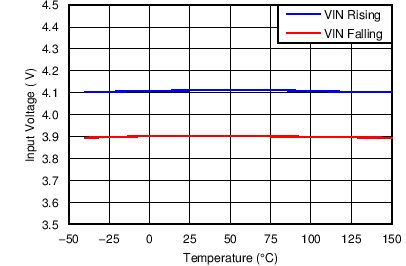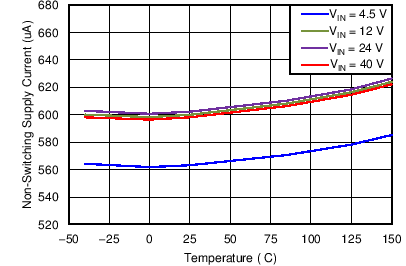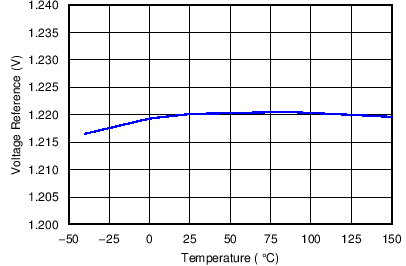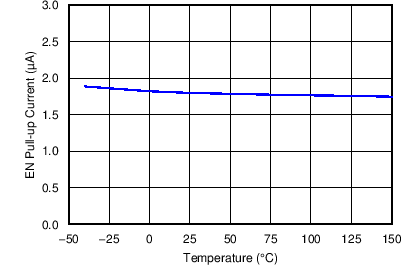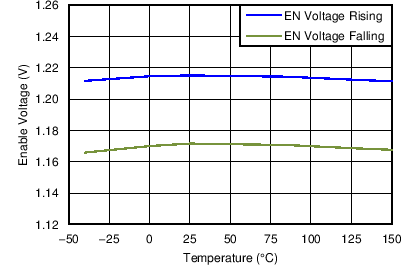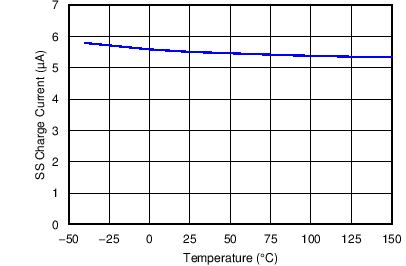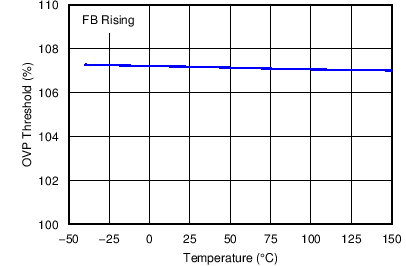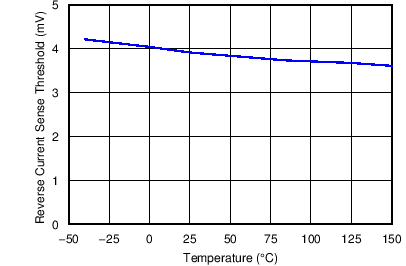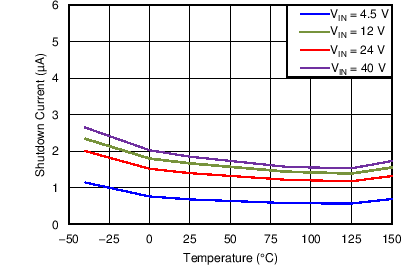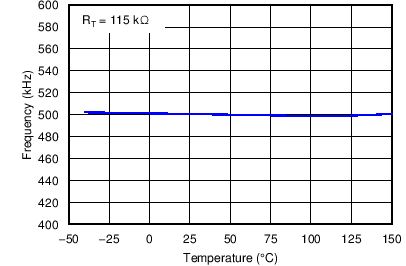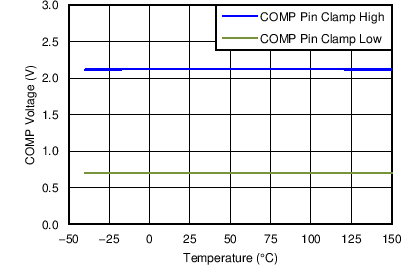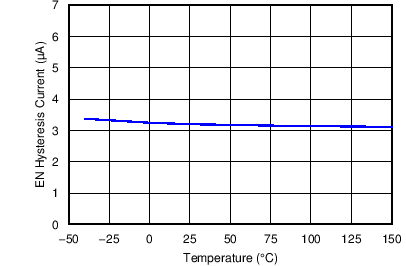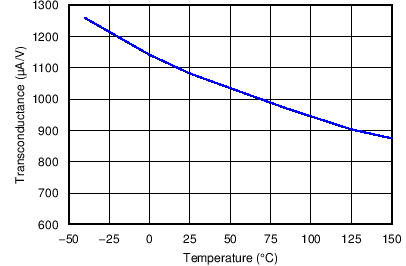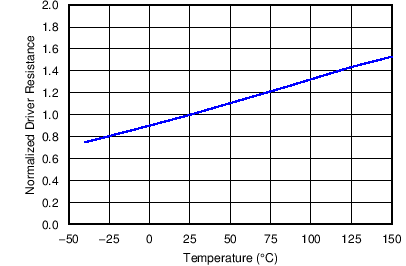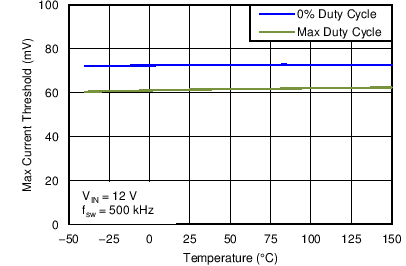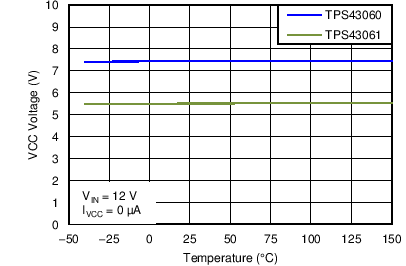-
TPS4306x Low Quiescent Current Synchronous Boost DC-DC Controller With Wide VIN Range
- 1 Features
- 2 Applications
- 3 Description
- 4 Simplified Schematic
- 5 Revision History
- 6 Pin Configuration and Functions
- 7 Specifications
-
8 Detailed Description
- 8.1 Overview
- 8.2 Functional Block Diagram
- 8.3
Feature Description
- 8.3.1 Switching Frequency
- 8.3.2 Low-Dropout Regulator
- 8.3.3 Input Undervoltage (UV)
- 8.3.4 Enable and Adjustable UVLO
- 8.3.5 Voltage Reference and Setting Output Voltage
- 8.3.6 Minimum On-Time and Pulse Skipping
- 8.3.7 Zero-Cross Detection and Duty Cycle
- 8.3.8 Minimum Off-Time and Maximum Duty Cycle
- 8.3.9 Soft-Start
- 8.3.10 Power Good
- 8.3.11 Overvoltage Protection (OVP)
- 8.3.12 OVP and Current Sense Resistor Selection
- 8.3.13 Gate Drivers
- 8.3.14 Thermal Shutdown
- 8.4 Device Functional Modes
-
9 Application and Implementation
- 9.1 Application Information
- 9.2
Typical Applications
- 9.2.1
Synchronous Boost Converter Typical Application Using TPS43061
- 9.2.1.1 Design Requirements
- 9.2.1.2
Detailed Design Procedure
- 9.2.1.2.1 Selecting the Switching Frequency
- 9.2.1.2.2 Inductor Selection
- 9.2.1.2.3 Selecting the Current Sense Resistor
- 9.2.1.2.4 Output Capacitor Selection
- 9.2.1.2.5 MOSFET Selection - NexFET Power Block
- 9.2.1.2.6 Bootstrap Capacitor Selection
- 9.2.1.2.7 VCC Capacitor
- 9.2.1.2.8 Input Capacitor
- 9.2.1.2.9 Output Voltage and Feedback Resistors Selection
- 9.2.1.2.10 Setting the Soft-Start Time
- 9.2.1.2.11 UVLO Set Point
- 9.2.1.2.12 Power Good Resistor Selection
- 9.2.1.2.13 Control Loop Compensation
- 9.2.1.2.14 DCM, Pulse-Skip Mode, and No-Load Input Current
- 9.2.1.3 Application Curves
- 9.2.2 High-Efficiency 40-V Synchronous Boost Converter Typical Application Using TPS43060
- 9.2.1
Synchronous Boost Converter Typical Application Using TPS43061
- 10Power Supply Recommendations
- 11Layout
- 12Device and Documentation Support
- 13Mechanical, Packaging, and Orderable Information
- IMPORTANT NOTICE
Package Options
Mechanical Data (Package|Pins)
- RTE|16
Thermal pad, mechanical data (Package|Pins)
- RTE|16
Orderable Information
TPS4306x Low Quiescent Current Synchronous Boost DC-DC Controller With Wide VIN Range
1 Features
- 58-V Maximum Output Voltage
- 4.5 to 38 V (40 V Absolute Max) VIN Range
- TPS43060: 7.5-V Gate Drive Optimized for Standard Threshold MOSFETs
- TPS43061: 5.5-V Gate Drive Optimized for Low Qg NexFET™ Power MOSFETs
- Current-Mode Control With Internal Slope Compensation
- Adjustable Frequency from 50 kHz to 1 MHz
- Synchronization Capability to External Clock
- Adjustable Soft-Start Time
- Inductor DCR or Resistor Current Sensing
- Output Voltage Power-Good Indicator
- ±0.8% Feedback Reference Voltage
- 5-µA Shutdown Supply Current
- 600-µA Operating Quiescent Current
- Integrated Bootstrap Diode (TPS43061)
- Cycle-by-Cycle Current Limit and Thermal Shutdown
- Adjustable Undervoltage Lockout (UVLO) and Output Overvoltage Protection
- Small 16-Pin WQFN (3 mm × 3 mm) Package With PowerPAD™
- –40°C to 150°C Operating TJ Range
2 Applications
- Thunderbolt Port for PCs
- Automotive Power Systems
- Synchronous Flyback
- GaN RF Power Amplifiers
- Tablet Computer Accessories
- Battery-Powered Systems
- 5-V, 12-V, and 24-V DC Bus Power Systems
3 Description
The TPS43060 and TPS43061 are low IQ current-mode synchronous boost controllers with wide-input voltage range from 4.5 to 38 V (40 V absolute max) and boosted output range up to 58 V. Synchronous rectification enables high-efficiency for high-current applications, and lossless inductor DCR sensing further improves efficiency. The resulting low-power losses combined with a 3-mm × 3-mm WQFN-16 package with PowerPAD™ supports high power-density and high-reliability boost converter solutions over extended (–40°C to 150°C) temperature range.
The TPS43060 includes a 7.5-V gate drive supply, which is suitable to drive a broad range of MOSFETs. The TPS43061 has a 5.5-V gate drive supply and driver strength optimized for low Qg NexFET power MOSFETs. Also, TPS43061 provides an integrated bootstrap diode for the high-side gate driver to reduce the external parts count.
Device Information(1)
| PART NUMBER | PACKAGE | BODY SIZE (NOM) |
|---|---|---|
| TPS43060 | RTE (16) | 3.00 mm × 3.00 mm |
| TPS43061 |
- For all available packages, see the orderable addendum at the end of the data sheet.
4 Simplified Schematic

5 Revision History
Changes from C Revision (September 2013) to D Revision
- Added Handling Ratings table, Feature Description section, Device Functional Modes, Application and Implementation section, Power Supply Recommendations section, Layout section, Device and Documentation Support section, and Mechanical, Packaging, and Orderable Information section Go
Changes from B Revision (August 2013) to C Revision
- Deleted sections Layout Considerations and Thermal ConsiderationsGo
- Changed Equation 13 from Dmin to (1-Dmax), 60% to (1-60%) and 2.4 MHz to 1.6 MHzGo
- Changed 2 MHz to 1.6 MHz in para below Equation 13Go
- Changed in Equation 28 – DS(on)LS to DS(on)HSGo
- Changed in Equation 29 – from (60 ns + 65 ns) to (65 ns _65 ns)Go
- Changed in paragraph above Equation 37 - 1.93 kHz to 0.97 kHzGo
- Changed in Equation 38 – from 1.93 kHz to 0.97 kHzGo
- Changed in paragraph above Equation 43 – 7.44 kΩ to 7.45 kΩGo
- Changed in Equation 43 – 21 µF to 22 µF, 20 mΩ to 10 mΩ, 19.3 kHz to 14.5 kHz, = 7.44 to = 7.45, and deleted 3/40 factor from denominatorGo
Changes from A Revision (December 2012) to B Revision
Changes from * Revision (December 2012) to A Revision
- Changed the devices From: Preview To: ProductionGo
6 Pin Configuration and Functions

Pin Functions
| PIN | DESCRIPTION | |
|---|---|---|
| NAME | NO. | |
| RT/CLK | 1 | Resistor timing and external clock. An external resistor from this pin to the AGND pin programs the switching frequency between 50 kHz and 1 MHz. Driving the pin with an external clock between 300 kHz to 1 MHz synchronizes the switching frequency to the external clock. |
| SS | 2 | Soft-start programming pin. A capacitor between the SS pin and AGND pin sets soft-start time. |
| COMP | 3 | Output of the internal transconductance error amplifier. The feedback loop compensation network is connected from this pin to AGND. |
| FB | 4 | Error amplifier input and feedback pin for voltage regulation. Connect this pin to the center tap of a resistor divider to set the output voltage. |
| ISNS– | 5 | Inductor current sense comparator inverting input pin. This pin is normally connected to the inductor side of the current sense resistor. |
| ISNS+ | 6 | Inductor current sense comparator non-inverting input pin. This pin is normally connected to the VIN side of the current sense resistor. |
| VIN | 7 | The input supply pin to the IC. Connect VIN to a supply voltage between 4.5 and 38 V. It is acceptable for the voltage on the VIN pin to be different from the boost power stage input, ISNS+, and ISNS– pins. |
| LDRV | 8 | Low-side gate driver output. Connect this pin to the gate of the low-side N-channel MOSFET. When VIN bias is removed, an internal 200-kΩ resistor pulls LDRV to PGND. |
| PGND | 9 | Power ground of the IC. Connect this pin to the source of the low-side MOSFET. PGND should be connected to AGND via a single point on the PCB. |
| VCC | 10 | Output of an internal LDO and power supply for internal control circuits and gate drivers. VCC is typically 7.5 V for the TPS43060 and 5.5 V for the TPS43061. Connect a low-ESR ceramic capacitor from this pin to PGND. TI recommends a capacitance range from 0.47 to 10 µF. |
| BOOT | 11 | Bootstrap capacitor node for high-side MOSFET gate driver. Connect the bootstrap capacitor from this pin to the SW pin. For the TPS43060, also connect a bootstrap diode from VCC to BOOT. |
| SW | 12 | Switching node of the boost converter. Connect this pin to the junction of the drain of the low-side MOSFET, the source of high-side synchronous MOSFET, and the inductor. |
| HDRV | 13 | High-side gate driver output. Connect this pin to the gate of the high-side synchronous rectifier MOSFET. When VIN bias is removed, this pin is connected to SW through an internal 200-kΩ resistor. |
| PGOOD | 14 | Power good indicator. This pin is an open-drain output. TI recommends a 10-kΩ pullup resistor between PGOOD and VCC or an external logic supply pin. |
| EN | 15 | Enable pin with internal pullup current source. Floating this pin will enable the IC. Pull below 1.2 V to enter low current standby mode. Pull below 0.4 V to enter shutdown mode. The EN pin can be used to implement adjustable UVLO using two resistors. |
| AGND | 16 | Analog signal ground of the IC. AGND should be connected to PGND at a single point on the PCB. |
| PowerPAD | 17 | The PowerPAD should be connected to AGND. If possible, use thermal vias to connect to an internal ground plane for improved power dissipation. |
7 Specifications
7.1 Absolute Maximum Ratings
over operating free-air temperature (unless otherwise noted)| MIN | MAX | UNIT | ||
|---|---|---|---|---|
| Voltage | Input: VIN, EN, ISNS+, ISNS– | –0.3 | 40 | V |
| DC voltage: SW | –0.6 | 60 | V | |
| Transient voltage (10 ns max): SW | –2 | 60 | V | |
| FB, RT/CLK, COMP, SS | –0.3 | 3.6 | V | |
| BOOT, HDRV voltage with respect to ground | 65 | V | ||
| BOOT, HDRV voltage with respect to SW pin | 8 | V | ||
| VCC, PGOOD, LDRV | –0.3 | 8 | V | |
| Operating junction temperature | –40 | 150 | °C | |
7.2 Handling Ratings
| MIN | MAX | UNIT | |||
|---|---|---|---|---|---|
| Tstg | Storage temperature range | –65 | 150 | °C | |
| V(ESD) | Electrostatic discharge | Human body model (HBM), per ANSI/ESDA/JEDEC JS-001, all pins(1) | –2000 | 2000 | V |
| Charged device model (CDM), per JEDEC specification JESD22-C101, all pins(2) | –500 | 500 | |||
7.3 Recommended Operating Conditions
over operating free-air temperature range (unless otherwise noted)| MIN | NOM | MAX | UNIT | ||
|---|---|---|---|---|---|
| VIN | Input voltage range | 4.5 | 38 | V | |
| VOUT | Output voltage range | VIN | 58 | V | |
| VEN | EN voltage range | 0 | 38 | V | |
| VCLK | External switching frequency logic input range | 0 | 3.6 | V | |
| TJ | Operating junction temperature | –40 | 150 | °C | |
7.4 Thermal Characteristics
over operating free-air temperature range (unless otherwise noted)| THERMAL METRIC (1) | WQFN (16-PINS) |
UNIT | |
|---|---|---|---|
| RθJA | Junction-to-ambient thermal resistance | 65.7 | °C/W |
| RθJC(top) | Junction-to-case (top) thermal resistance | 42.3 | |
| RθJB | Junction-to-board thermal resistance | 18 | |
| ψJT | Junction-to-top characterization parameter | 0.9 | |
| ψJB | Junction-to-board characterization parameter | 17.9 | |
| RθJC(bot) | Junction-to-case (bottom) thermal resistance | 22.7 | |
7.5 Electrical Characteristics
VIN = 4.5 to 38 V, TJ = –40ºC to 150ºC, unless otherwise noted. Typical values are at TA = 25ºC7.6 Typical Characteristics
VIN = 12 V, ƒSW = 500 kHz, TA = 25ºC (unless otherwise noted)